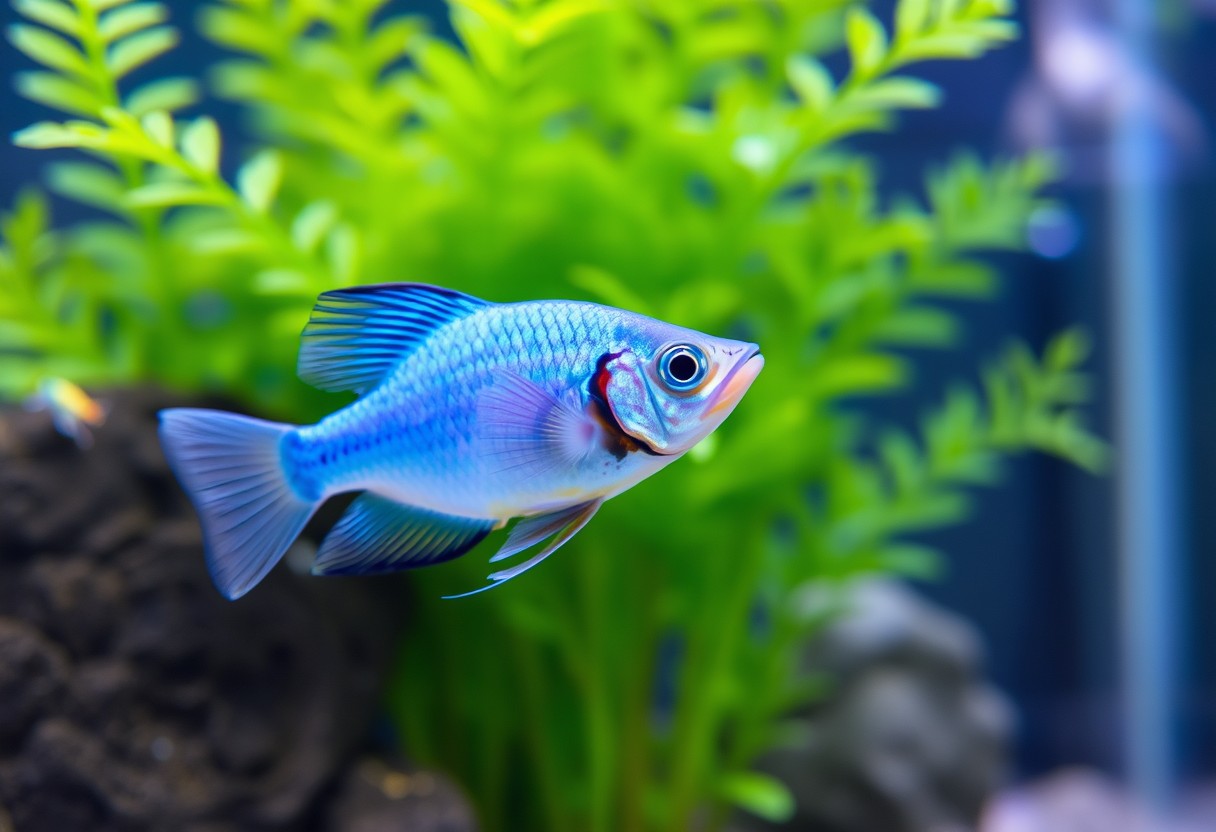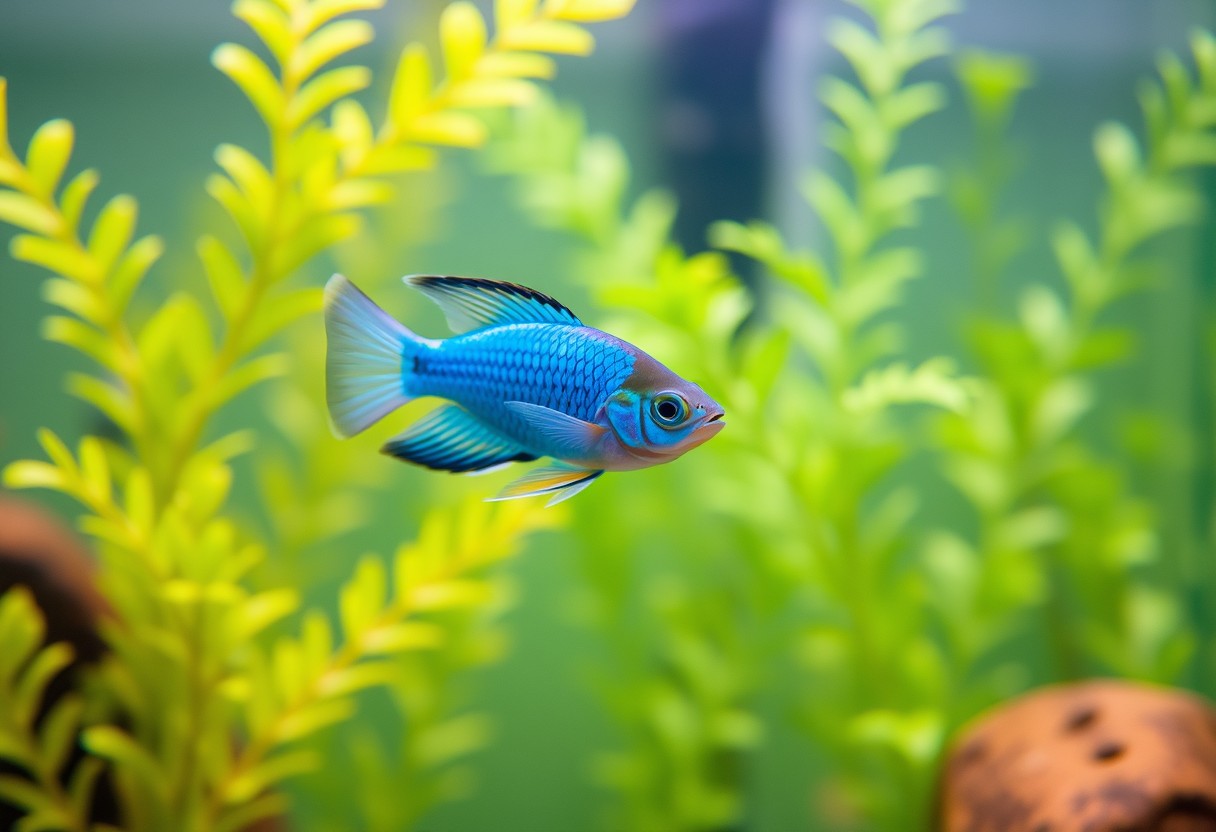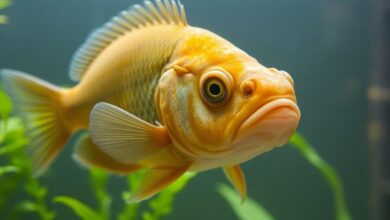Blue Molly Fish – 9 Essential Care Guidelines

Most aquarium enthusiasts appreciate the vibrant colors and hardy nature of Blue Molly fish, making them a popular choice for both beginners and seasoned aquarists alike. To ensure your Blue Molly thrives, you must understand their specific care needs, including water quality, tank mates, and diet. By following these important care guidelines, you can create an optimal environment for your fish and prevent common health issues that may arise. Get ready to enhance your aquarium with the beauty and charm of Blue Molly fish!
Key Takeaways:
- Tank Environment: Blue Molly fish thrive in a well-maintained tank with a minimum size of 20 gallons, stable water parameters, and plenty of hiding spots.
- Diet: A balanced diet is important; provide high-quality flake foods, as well as live or frozen foods to ensure they receive proper nutrition.
- Companionship: These fish are social creatures; keep them in groups of at least 5 to promote natural behavior and reduce stress.

Understanding Blue Molly Fish
To care effectively for your Blue Molly fish, you must first understand their origins and behaviors. This species of fish, known for its vibrant hues and striking patterns, belongs to the Poeciliidae family. With a gentle demeanor and sociable nature, they make an excellent addition to community tanks. Knowledge of their background can help you create an environment that keeps them healthy and thriving in your aquarium.
Natural Habitat
Natural habitats of Blue Molly fish are typically found in freshwater environments like rivers, ponds, and marshes in Central and South America, where they thrive in warm temperatures and moderate water conditions. Understanding their natural surroundings can aid you in replicating a stable and healthy environment for your fish.
Behavior and Temperament
Behaviorally, Blue Molly fish are known for their peaceful and social nature. They often thrive in community tanks with other non-aggressive species. However, you should note that they can show signs of aggression when provoked or if their space is invaded by more territorial fish. It’s important to monitor their interactions and keep them housed with compatible tank mates to ensure a harmonious environment.
The underlying temperament of Blue Molly fish is both friendly and active, making them delightful to observe in your aquarium. They tend to school together, creating a vibrant display of movement and color. You will find that fostering a suitable and spacious habitat can help minimize stress and aggression. Also, keeping them in groups of at least three will promote their well-being and reduce any harmful behaviors. Note, providing a stable environment with appropriate tank mates allows your Blue Molly fish to thrive and showcase their true charm.
Ideal Tank Conditions
The Blue Molly fish thrives in specific tank conditions that ensure its health and well-being. Maintaining the right environment will enable you to enjoy these lively creatures while providing a suitable habitat for them to flourish.
Tank Size and Setup
For Blue Molly fish, a minimum tank size of 20 gallons is recommended to allow them ample swimming space and to maintain stable water parameters. Include plenty of plants, rocks, and hiding spots to create a natural habitat and reduce stress. Ensure the tank is well-filtered and equipped with a heater, as these fish prefer a temperature range of 72-78°F.
Water Quality and Parameters
Size does matter when it comes to water quality and parameters, as these elements significantly impact the health of your Blue Molly fish. Aim for a pH level between 7.0 and 8.5, with hardness ranging from 10 to 25 dGH. Consistent ammonia and nitrite levels at 0 ppm are crucial, while nitrate levels should be kept below 20 ppm for optimal health.
With regular water changes of about 25% weekly and careful monitoring of your tank’s chemical balance, you can create an ideal environment for your Blue Molly fish. Maintaining the right water temperature and parameters not only supports their vitality but also reduces the risk of diseases. The right water conditions significantly improve their growth and behavior, making them a delight to observe in your aquarium.

Feeding the Blue Molly Fish
Many aquarists find feeding the Blue Molly fish straightforward due to their adaptable nature. However, providing a balanced diet is key to maintaining their health and vibrant colors. You should ensure that your fish receive a mix of quality foods to replicate their natural diet, which consists mainly of plant matter, algae, and small zoo-plankton.
Nutritional Needs
Feeding your Blue Molly fish requires a well-rounded approach to meet their nutritional needs. These fish thrive on a diet rich in carbohydrates, plant-based proteins, and imperative vitamins. To support their overall well-being, focus on providing foods that cater to their omnivorous nature.
Recommended Diet
Needs for a balanced diet include high-quality flake food, pellets, and frozen or live foods. Offer a variety of spirulina-based flakes, algae wafers, and fresh vegetables like blanched zucchini or spinach. This diversity ensures your Blue Mollys receive the necessary nutrients for proper growth and color enhancement.
Understanding the importance of variety in your Blue Molly’s diet helps prevent nutritional deficiencies. Incorporating an assortment of foods, including high-quality flakes and live foods, ensures your fish receive imperative nutrients. Be cautious not to overfeed; smaller, frequent meals are preferred over a single large feeding to avoid health issues. Additionally, consider occasional treats of frozen brine shrimp or daphnia to keep your fish active and engaged while promoting their overall health.
Breeding Blue Molly Fish
Unlike many other freshwater fish, breeding Blue Molly Fish can be a rewarding experience due to their relatively high fertility and ease of care. These livebearers often produce multiple fry at once, making them perfect for aquarium enthusiasts looking to expand their stock. To ensure successful breeding, you must provide optimal water conditions and a stress-free environment, allowing your fish to thrive and reproduce naturally.
Breeding Setup
One of the first steps in breeding Blue Molly Fish is to create a suitable breeding setup. You should provide a separate breeding tank that is at least 10 gallons in size, equipped with a sponge filter to maintain water quality without harming the fry. Ensure the tank has plenty of hiding spots using live plants or decorations, as this will help protect the fry from being eaten by their parents.
Care for Fry
An crucial part of successfully breeding Blue Molly Fish is caring for the fry after they are born. You’ll want to ensure that the fry have a safe environment to grow and develop, free from predators. It’s crucial to maintain excellent water conditions and feed them appropriately to encourage healthy growth.
The first few weeks after birth are critical for the fry’s survival, as they are quite vulnerable. You should use a fine powdered food or specialized fry food to ensure they receive enough nutrients. Maintaining stable water parameters is vital, as any drastic changes can harm the fry. Furthermore, it’s important to provide gentle filtration and monitor the fry for signs of stress, ensuring they have a safe and nurturing environment to grow into healthy adult fish.
Disease Prevention and Treatment
Despite your best efforts in maintaining a clean and stable environment, Blue Molly fish can still be susceptible to various diseases. Preventive measures are crucial, including regular water testing and maintaining optimal water conditions. Ensure that your fish receive a well-balanced diet and avoid overcrowding in the tank. Quarantining new fish before introducing them to your established tank can also protect your Blue Mollies from potential pathogens.
Common Illnesses
With proper care, your Blue Molly fish can thrive, but they are prone to common illnesses such as fin rot, white spot disease (ich), and velvet disease. Recognizing early signs is vital; look out for abnormal behavior, discoloration, and visible sores. Regular observation of your fish will help you catch these issues before they escalate.
Treatment Options
Treatment options vary depending on the illness, but several common remedies exist. Medications specifically designed for your fish’s ailments can be effective. Always follow the manufacturer’s guidelines and observe the fish for reactions during treatment.
Another option is to create a quarantine tank to isolate sick fish from the others. This not only prevents the spread of diseases but allows for focused treatment measures like salt baths or medicated food. Additionally, maintaining a stress-free environment through optimal water quality and a varied diet can significantly enhance your fish’s ability to recover. Ignoring these treatments could lead to more severe complications, so timely action is important to protect your Blue Mollies.

Compatibility with Other Fish
Now, ensuring compatibility is vital when introducing Blue Molly fish to your aquarium. These peaceful fish usually thrive in community tanks, but careful consideration of their tank mates is necessary to maintain a harmonious environment. Selecting the right companions will not only promote stress-free living but also enhance your aquarium’s overall biodiversity.
Suitable Tank Mates
Fish like guppies, platies, and swordtails work well with Blue Molly fish since they share similar water parameters and temperaments. Avoid aggressive or overly territorial species, as they can cause stress and potentially harm your Mollies. Aim for peaceful community members that contribute to a balanced ecosystem in your tank.
Aggression and Social Behavior
Any level of aggression can be detrimental in a community tank featuring Blue Molly fish. These fish are generally peaceful; however, you must be cautious of their social dynamics. They do better in larger schools, which helps diffuse any minor territorial disputes and reduces stress levels.
Compatibility is key to a healthy aquarium environment. While Blue Molly fish are largely peaceful, increased aggression can occur if they feel threatened or if they are in too small a group. It’s crucial to provide them with adequate space, allowing for natural social behaviors. When choosing tank mates, avoid aggressive species and consider optimizing your Molly’s social structure by keeping them in groups of at least three to five fish. This balance helps minimize any aggressive tendencies and promotes a thriving community.
To wrap up
Following this comprehensive guide on caring for Blue Molly Fish, you can ensure they thrive in your aquarium. Remember to maintain a stable environment, provide a balanced diet, and monitor their health regularly. By understanding their specific needs, you can create a healthy habitat that fosters their natural behaviors. For further details, refer to the Molly Care Sheet: Food, Tank Size, Compatibility to enhance your care routine.
FAQ
Q: What are the ideal water conditions for keeping Blue Molly Fish?
A: Blue Molly Fish thrive in freshwater environments with specific water parameters. The ideal temperature range is between 76°F to 82°F (24°C to 28°C). The pH level should be maintained between 7.0 and 8.5, while the hardness should fall between 10 to 25 dGH. It is crucial to use a good filtration system to ensure clean and well-oxygenated water, as Molly Fish are sensitive to poor water quality. Regular water changes of 20-25% weekly are also recommended to maintain a healthy environment.
Q: What should I feed my Blue Molly Fish to ensure they stay healthy?
A: Blue Molly Fish are omnivorous, which means their diet can include a mixture of plant-based foods and protein sources. It is recommended to feed them a high-quality flake food or pellet that contains spirulina algae, as this will promote their overall health and coloration. Additionally, you can supplement their diet with frozen or live foods like brine shrimp, daphnia, or bloodworms, along with blanched vegetables like zucchini or spinach. Feeding 1-2 times a day in small amounts that they can consume within a few minutes is ideal to prevent overfeeding.
Q: Can Blue Molly Fish be kept with other species in a community tank?
A: Yes, Blue Molly Fish can be kept in a community tank with other peaceful and compatible fish species. Good tank mates include Guppies, Platies, Swordtails, and Corydoras Catfish. However, it is advisable to avoid keeping them with aggressive or territorial species, as well as very small fish that may be viewed as prey. When setting up a community tank, ensuring there is enough space and hiding places will help reduce stress and aggression among the fish. Monitoring behavior regularly will also help ensure all tank inhabitants are coexisting harmoniously.





